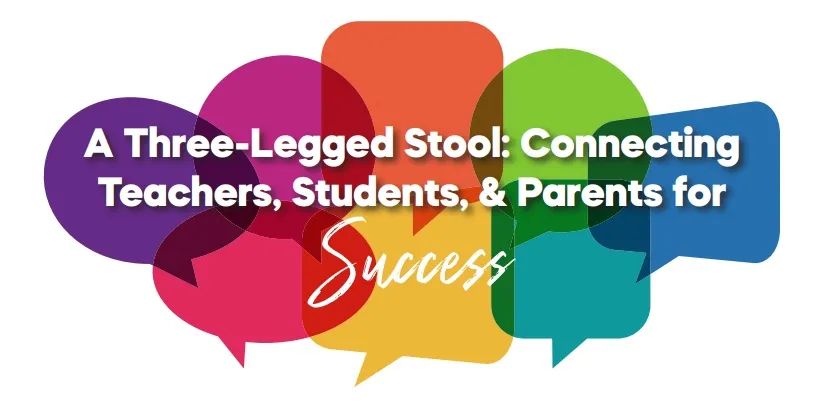

A Three-Legged Stool: Connecting Teachers, Students, & Parents for Success
November 2022
by Kelly McCandless
A lesson Tegan Leffler learned early in her teaching career was the importance of communication and connection. Her teaching partner in her first year described building a three-legged stool for each student, ensuring a connection between her, her student, and her student’s family.
Leffler, who teaches first grade at Sandstone Elementary, has been a teacher in School District 2 for 21 years and carries the stool approach with her to this day. In addition to an early established love for children, Leffler comes from a family of educators. She’s taught kindergarten, first grade, and Reading Intervention; her passion for her profession is genuine, and she is quick to note how important relationship building is to the success of her students.
As a teacher of younger children, Leffler works with students first. “I try to get to know their personalities, what makes them tick, what makes them happy, and how they see themselves,” she said. Once she has a good grasp on the individual student, she reaches out to their family. “Every family is different, and sometimes I reach out sooner than others. Things like Open House, Meet and Greet events, and Parent Teacher Conferences help put faces to names and allow us to know a bit about who the family is.”
Why Relationships Are Critical
Teachers lean on families for guidance. While teachers spend a significant amount of time with students, they are not privy to the things happening beyond the school. Leffler described how helpful it can be when a parent or caregiver reaches out with information. “It can be as simple as telling me they had a rough morning and may need a little extra connection at school that day, or more complex in letting me know about a new pet, the death of a loved one, or changes at home. I don’t need details, but if I have some idea that something is impacting a student, the doors open much wider for me to be supportive.”
As a parent herself, Leffler understands the juggling happening at home and that in most situations, families are giving what they can. In some cases, families may not be sure what the teacher needs from them. She keeps it as simple as possible for families and always puts the student first.
Accountability for All
With younger students, the student-teacher-family relationship looks different than in middle and high school. But the theme remains the same: if something seems off with a student, and the teacher has no idea what is going on, it is extremely difficult to build a support system. As students mature, they take on a larger role in reporting and advocating for themselves, but support at home remains critical.
“We have to be super careful as teachers that we don’t get pulled into the middle of family situations, particularly legal situations. We lean on the administration to help us and seek additional resources for our kids. We need to know our kids and what’s going on with families, but we have to set boundaries, too,” Leffler explained.
Returning to the three-legged stool concept when issues arise at school helps create a plan for communication and resolution. “In everything I do, I remember and remind that the child is our number one priority.” -Tegan Leffler “As a teacher, it’s so important to have a good rapport with families, so I try very hard to ensure a concerned parent/caregiver feels heard and understood while also getting my own point across,” explained Leffler.
The bottom line? Teachers play a vital role in the lives of children and get to know them in an environment parents/caregivers are somewhat separate from. Remembering that there are multiple people with accountability in any given situation can be tremendously helpful when confronting an issue or concern.
What Works
Teachers will have 18 – 30 students in their class at the primary grade level. That number multiplies exponentially for middle and high school teachers. Waiting for them to contact you as a parent or caregiver may not be the most practical approach. “Reaching out and making a connection with the teacher is so great,” Leffler said. “Say hi, introduce yourself. Be present in person if you can; if you can’t, send a message and make a connection.” A phone call, email, or message through classroom apps goes far in establishing a relationship.
Teachers spend significant time with their students, no matter the grade level. They see their friends, their struggles, and their accomplishments. Reach out to them with your questions, check in, and ask how things are going. In most cases, the teacher will be happy to give a quick update and share their insights with you on how things are going at school.
Leffler summed up the three-legged stool approach simply: “If I don’t have a relationship with the family, the stool fails. If I don’t have a relationship with the kiddo, the stool fails. It takes all three of us working together to create success.”
How to Touch Base
Remember that teachers are working through most of the school day and may not have the opportunity to respond immediately. Using classroom apps like Google Classroom, SeeSaw, and Remind, sending an email, or calling the teacher’s classroom phone number and leaving a message are simple ways to reach out that allow the teacher to connect with you as soon as they’re able.
If a pressing or urgent concern arises, it’s more appropriate to call the school’s main phone line to reach a secretary or administrator quickly.
Never miss an issue, check out SLM's digital editions here!





